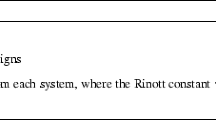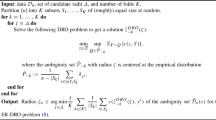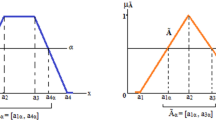Abstract
This article presents the optimal Bayesian acceptance sampling plan (BASP) for two sample cases. In constructing the BASP, the decision-theoretic approach is used with a specified loss function, and the Bayes decision rule is developed by minimizing the Bayes risk. Both batches of products from the production line are accepted or rejected simultaneously based on the observed sample. Such implementation has a significant advantage in reducing the cost and time by deciding on the acceptance or rejection of both the batches in a single-life testing experiment. The optimal BASP is derived under the assumption of Weibull and exponential lifetimes, although it can be extended for other lifetime distributions also. Some numerical results have been presented to show the performances of the proposed BASP. We have presented the analysis of two data sets; (i) real and (ii) simulated, mainly to show how the proposed method can be used in practice.

Similar content being viewed by others
References
Aslam, M. (2018). Design of sampling plan for exponential distribution under neutrosophic statistical interval method. IEEE Access, 6, 64153–64158.
Aslam, M., Srinivasa Rao, G., & Khan, N. (2021). Single-stage and two-stage total failure-based group-sampling plans for the Weibull distribution under neutrosophic statistics. Complex & Intelligent Systems, 7, 891–900.
Aslam, M., Rao, G. S., Khan, N., & Ahmad, L. (2022). Two-stage sampling plan using process loss index under neutrosophic statistics. Communications in Statistics-Simulation and Computation, 51(6), 2831–2841.
Chen, L. S., Liang, T., & Yang, M. C. (2023). Designing efficient Bayesian sampling plans based on the simple step-stress test under random stress-change time for censored data. Journal of Statistical Computation and Simulation, 93(7), 1104–29.
Chen, L. S., Liang, T., & Yang, M. C. (2022). Designing Bayesian sampling plans for simple step-stress of accelerated life test on censored data. Journal of Statistical Computation and Simulation, 92(2), 395–415.
Chen, L. S., Yang, M. C., & Liang, T. (2017). Curtailed Bayesian sampling plans for exponential distributions based on type-II censored samples. Journal of Statistical Computation and Simulation, 87, 1160–1178.
Chen, L. S., Yang, M. C., & Liang, T. (2015). Bayesian sampling plans for exponential distributions with interval censored samples. Naval Research Logistics (NRL), 62(7), 604–616.
Chen, J., Li, K. H., & Lam, Y. (2007). Bayesian single and double variable sampling plans for the Weibull distribution with censoring. European Journal of Operational Research, 177(2), 1062–1073.
Chen, J., Choy, S. B., & Li, K. H. (2004). Optimal Bayesian sampling acceptance plan with random censoring. European Journal of Operational Research, 155(3), 683–694.
Chen, J., Chou, W., Wu, H., & Zhou, H. (2004). Designing acceptance sampling schemes for life testing with mixed censoring. Naval Research Logistics (NRL), 51, 597–612.
Huang, Y. S., Hsieh, C. H., & Ho, J. W. (2008). Decisions on an optimal life test sampling plan with warranty considerations. IEEE Transactions on Reliability, 57(4), 643–649.
Huang, W. T., & Lin, Y. P. (2004). Bayesian sampling plans for exponential distribution based on uniform random censored data. Computational Statistics and Data Analysis, 44, 669–691.
Kundu, D. (2013). Bayesian analysis for partially complete time and type of failure data. Journal of Applied Statistics, 40(6), 1289–1300.
Kundu, D., & Pradhan, B. (2011). Bayesian analysis of progressively censored competing risks data. Sankhya B, 73(2), 276–296.
Lam, Y. (1990). An optimal single variable sampling plan with censoring. The Statistician, 39, 53–66.
Lam, Y. (1994). Bayesian variable sampling plans for the exponential distribution with type-I censoring. The Annals of Statistics, 22, 696–711.
Lam, Y., & Choy, S. T. B. (1995). Bayesian variable sampling plans for the exponential distribution with uniformly distributed random censoring. Journal of Statistical Planning and Inference, 47, 277–293.
Liang, T., & Yang, M. C. (2013). Optimal Bayesian sampling plans for exponential distributions based on hybrid censored samples. Journal of Statistical Computation and Simulation, 83, 922–940.
Lin, C. T., Huang, Y., & Balakrishnan, N. (2008). Exact Bayesian variable sampling plans for the exponential distribution based on type-I and type-II hybrid censored samples. Communications in Statistics Simulation and Computation, 37, 1101–1116.
Lin, C. T., Huang, Y., & Balakrishnan, N. (2010). Corrections on Exact Bayesian variable sampling plans for the exponential distribution based on type-I and type-II hybrid censored samples. Communications in Statistics: Simulation and Computation, 39, 1499–1505.
Lin, C. T., Huang, Y. L., & Balakrishnan, N. (2011). Exact Bayesian variable sampling plans for the exponential distribution with progressive hybrid censoring. Journal of Statistical Computation and Simulation, 81, 873–882.
Lin, Y., Liang, T., & Huang, W. (2002). Bayesian sampling plans for exponential distribution based on type-I censoring data. Annals of the Institute of Statistical Mathematics, 54, 100–113.
Mondal, S., Bhattacharya, R., Pradhan, B., & Kundu, D. (2020). Bayesian optimal life testing plan under the balanced two sample type-II progressive censoring scheme. Applied Stochastic Models in Business and Industry, 36(4), 628–640. https://doi.org/10.1002/asmb.2519
Mondal, S., & Kundu, D. (2019). A new two sample type-II progressive censoring scheme. Communications in Statistics - Theory and Methods, 48(10), 2602–2618.
Mondal, S., & Kundu, D. (2019). Bayesian inference for weibull distribution under the balanced joint type-II progressive censoring scheme. American Journal of Mathematical and Management Sciences, 39(1), 56–74.
Mondal, S., & Kundu, D. (2019). Exact inference on multiple exponential populations under a joint type-II progressive censoring scheme. Statistics, 53(6), 1329–1356.
Pena, E. A., & Gupta, A. K. (1990). Bayes estimation for the Marshall–Olkin exponential distribution. Journal of the Royal Statistical Society Series B, 52, 379–389.
Prajapati, D., Mitra, S., & Kundu, D. (2019). A new decision theoretic sampling plan for type-I and type-I hybrid censored samples from the exponential distribution. Sankhya B, 81(2), 251–88.
Prajapati, D., Mitra, S., & Kundu, D. (2020). A new decision theoretic sampling plan for exponential distribution under type-I Censoring. Communications in Statistics - Simulation and Computation, 49(2), 453–71.
Prajapati, D., Mitra, S., & Kundu, D. (2020). Bayesian sampling plan for the exponential distribution with generalized type - II hybrid censoring scheme. Communications in Statistics - Simulation and Computation. https://doi.org/10.1080/03610918.2020.1861293
Prajapati, D., Mondal, S., & Kundu, D. (2021). Optimal decision-theoretic sampling plan for two exponential distributions under joint censoring scheme. Applied Stochastic Models in Business and Industry, 37, 560–576.
Prajapati, D., Mitra, S., Kundu, D., & Pal, A. (2023). Optimal Bayesian sampling plan for censored competing risks data. Journal of Statistical Computation and Simulation, 5, 775–99.
Prajapati, D., & Kundu, D. (2023). Bayesian acceptance sampling plan for simple step-stress model. Communications in Statistics-Simulation and Computation. https://doi.org/10.1080/03610918.2023.2234664
Proschan, F. (1963). Theoretical explanation of observed decreasing failure rate. Technometrics, 5, 375–383.
Srivastava, J. N. (1987). More efficient and less time-consuming censoring design for testing. Journal of Statistical Planning and Inference, 16, 389–413.
Tsai, T. R., Chiang, J. Y., Liang, T., & Yang, M. C. (2014). Efficient Bayesian sampling plans for exponential distributions with type-I censored samples. Journal of Statistical Computation and Simulation, 84, 964–981.
Yang, M. C., Chen, L. S., & Liang, T. (2017). Optimal Bayesian variable sampling plans for exponential distributions based on modified type-II hybrid censored samples. Communications in Statistics-Simulation and Computation, 46, 4722–4744.
Acknowledgements
The authors would like to thank the reviewers for their constructive comments which have helped to improve the manuscript significantly.
Author information
Authors and Affiliations
Corresponding author
Ethics declarations
Conflict of interest
Author 1 declares that he/she has no conflict of interest. Author 2 declares that he/she has no conflict of interest. Author 3 declares that he/she has no conflict of interest.
Ethical approval
This article does not contain any studies with human participants or animals performed by any of the authors.
Additional information
Publisher's Note
Springer Nature remains neutral with regard to jurisdictional claims in published maps and institutional affiliations.
Appendices
Appendix
1.1 Calculation of \(\phi ({\textbf {W,Z}})\) in Weibull distribution
where
Similarly,
Proof of Theorem 4.1
(a) For the fixed \(k_1\) and \(k_2\), let us denote \(\phi (k_1,k_2,u)=E[g(\lambda _1,\lambda _2)|k_1,k_2,u].\) The joint posterior PDF of \(\lambda _1\) and \(\lambda _2\) can be obtained as
Simplifying we obtain \((\lambda _1,\lambda _2)| (k_1,k_2,u) \sim BG(a_0+k,b_0+u,a_1+k_1,a_2+k_2)\) which implies that the Beta-Gamma is a conjugate prior. Therefore it is straight forward that
Let us define \(\displaystyle \eta =\frac{\lambda _1}{\lambda _1+\lambda _2}\) and \(\displaystyle \lambda = \lambda _1+\lambda _2 \) then by the following one-to-one transformation \(\lambda _1=\lambda \eta \) and \(\lambda _2= \lambda (1-\eta ),\) the joint posterior density function of \(\lambda _1\) and \(\lambda _2\) is
Note that for a fixed \(k_1\) and \(k_2,\) the posterior density function of \(\eta | (k_1,k_2,u)\) is constant w.r.t. u, and the posterior density function of \(\lambda |(k_1,k_2,u)\) is a function of u. Since the distribution function of \(\lambda |(k_1,k_2,u)\) is gamma which belongs to the exponential family, it has Monotone Likelihood Ratio (MLR) property. Then it is straightforward to show that for \(u_1 < u_2,\) the likelihood ratio \(\frac{\pi (\lambda |k_1,k_2,u_1)}{\pi (\lambda |k_1,k_2,u_2)}\) is strictly increasing in \(\lambda .\) Therefore, the posterior distribution of \(\lambda |(k_1,k_2,u)\) is stochastically decreasing function of u, and hence due to (20) the joint posterior distribution of \((\lambda _1,\lambda _2)|(k_1,k_2,u)\) is stochastically decreasing function of u. So, if \(g(\lambda _1, \lambda _2)\) is a positive function in \(\lambda _1, \lambda _2\) and \(u_1<u_2,\) then
which implies that \( \phi (k_1,k_2,u_1)> \phi (k_1,k_2,u_2). \) Hence \(\phi (k_1,k_2,u)\) is strictly decreasing in u for fixed \(k_1\) and \(k_2.\)
(b) From (a), it is straightforward that \(\delta _B\) is strictly increasing in u for fixed \(k_1\) and \(k_2.\)
Bayes risk derivation in exponential distribution
The Bayes risk is given by
where
Since \(\displaystyle \frac{\lambda _1}{\lambda }\) and \(\lambda \) is independent we can write
where
\(S_{r}=\frac{\xi (r,k-r)}{b_0}\)and \(I_{S_r}(k,p_i+q_i+a_0)=\frac{B_{S_r}(k,p_i+q_i+a_0)}{B(k,p_i+q_i+a_0)},\) and \(B(a,b)=\int _{0}^{1}z^{a-1}(1-z)^{b-1}dz=\frac{\Gamma (a)\Gamma (b)}{\Gamma (a+b)}\) is the beta function, and \(B_{x}(a,b)=\int _{0}^{x}u^{a -1}(1-u)^{b-1}du, \ \text {where} \ 0\le x \le 1,\) is the incomplete beta function. We denote the cumulative distribution function of beta as, \( I_x(a, b)=\frac{B_x(a, b)}{B(a, b)}. \) Then Bayes risk is given as
where \(K_1(K_2)\) follows a Binomial distribution with parameters k and \(\frac{\lambda _1}{\lambda } (\frac{\lambda _2}{\lambda }),\) therefore
similarly,\( \displaystyle \ E(K_2) = k \frac{B(a_1, a_2 +1)}{B(a_1, a_2)}\), and from Mondal and Kundu (2019a) for all \(i=1, \ldots , k,\) \(W_i = \sum _{s=1}^{i}V_s\), where \(V_s \sim Exp(\frac{1}{E_s})\) independently and \(E_s= \lambda (n-\sum _{j=1}^{s-1}(R_j+1)),\) using this the \(E[W_k]\) is given as
Therefore, \(E(W_k)\) exists only if \(a_0>1.\)
1.1 Proof of Theorem 3.1
Let \((n_B, k_B, R_{1_B}, \ldots , R_{k_{B}-1}, \delta _B)\) be the optimal BASP, then minimum Bayes risk is given by \(R_{B}^{\delta _B}(n_B, k_B, R_{1_B}, \ldots , R_{k_{B}-1})\). Let \((0,0,0, \ldots , 0,\delta _{B}=0)\) denote the sampling plan, when we reject the batch without sampling with Bayes risk \(R_{B}^{\delta _{B}=0}(0,0, 0, \ldots , 0)= C_r\) and \((0,0, 0, \ldots , 0,\delta _{B}=1)\) denote the sampling plan when we accept the batch without sampling with Bayes risk \(R_{B}^{\delta _{B}=1}(0,0,0, \ldots , 0)= E_{\alpha , \lambda _1, \lambda _2}[g(\alpha , \lambda _1,\lambda _2)]\). Then the Bayes risk of optimal BASP is
From (5) it is clear that
Now from (22) and (21), it follows that
which implies that
and \(0\le k_{B}\le n_{B}.\)
Rights and permissions
Springer Nature or its licensor (e.g. a society or other partner) holds exclusive rights to this article under a publishing agreement with the author(s) or other rightsholder(s); author self-archiving of the accepted manuscript version of this article is solely governed by the terms of such publishing agreement and applicable law.
About this article
Cite this article
Prajapati, D., Mondal, S. & Kundu, D. Two sample Bayesian acceptance sampling plan. Ann Oper Res (2024). https://doi.org/10.1007/s10479-023-05804-6
Received:
Accepted:
Published:
DOI: https://doi.org/10.1007/s10479-023-05804-6




